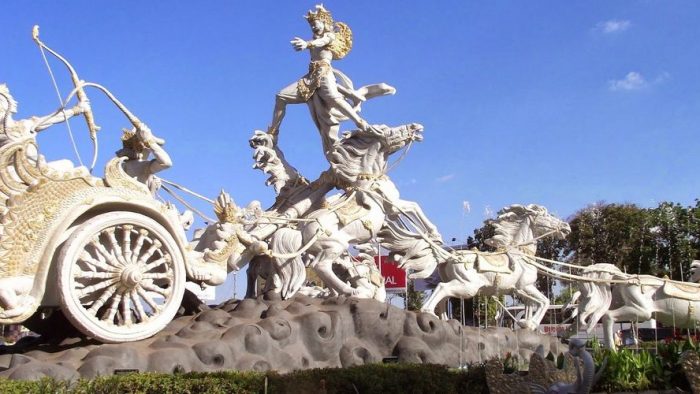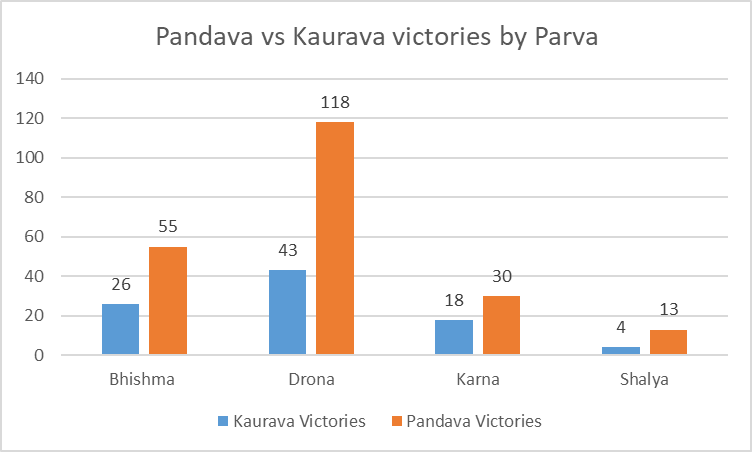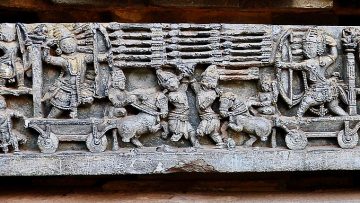The epic battle of Mahabharata is an event that has been etched in the memory and imagination of Indians and Hindus since millennia. And it shall continue to do so, for scholars and common folk alike.
The imminent result of a long drawn feud among the Kuru family, between the sons of Pandu and those of Dhritarashtra soon blew up into a confrontation that drew participation from entire Bharatavarsha. The war raged over eighteen days, claimed the lives of eighteen Akshauhinis of Armies that poured from all over ancient, undivided India and beyond. The luckier ones that survived the battlefield found themselves perishing in the midnight massacre on the night of eighteenth day, by Ashvatthama.
Scholars and storytellers have been trying to draw and enunciate the innumerable lessons that the epic battle has instore for mankind, of courage, of wisdom, of gratitude, of ethics and of the never-ending pursuit for the knowledge of Dharma. As commentaries have been written upon the qualitative studies conducted by schools, Ashramas and gurus, a quantitative study of the battle would have its own set of inputs and insights to add. Especially about the magnitude and scale of the war, about the personal or family feuds, about long forgotten heroes and stories ignored (wilfully or otherwise) by popular adaptations and renditions.
It was with this thought in mind that I had started upon the exercise of compilation of individual confrontations of Kurukshetra war into a spreadsheet database. The exercise started in June 2019 and the detail was daunting as well as mesmerizing, because of which I first set upon summarizing each battle (also tweeting it in a thread) and then capturing the result of each battle. There were complications that arose owing to the real and complex nature of the battle. Confrontations were of three kinds (mainly)
- General battles where multiple warriors from one side would clash with multiple warriors from the other camp- These general battles, eventually would end up breaking down into smaller general battles or into individual duels
- Individual duels are one-one battles between two ranked warriors which would end in one of them dying or withdrawing. Some cases exist where both of them fainted and were carried away by their friends from the confrontation place. Some of them had to be stopped without result, mid duel because of the sun setting. (It was against the code to fight after sunset, a rule diligently followed except on day 14 of the war)
- Cumulative battles where multiple warriors from one side would attack a single warrior, mostly because he is in a form that could overwhelm any individual warrior and the losses he would be causing if unchecked would be huge. (The notorious example of a cumulative attack was the one made on Abhimanyu on the thirteenth day of the war when he was caught inside the Chakravyuha with any help cut off because of Jayadrata)
The realistic nature of the battle clearly reflects in the melee and chaos even in the poetic description of Mahabharata where a duel often dissolves into a general battle or vice versa, ending up with a no result despite the effort exerted. There are also cases where a duel that promises a clear result would become a cumulative attack because one of the warriors would start dominating which is not acceptable to the friends of the disadvantaged warrior and hence, they would jump in to surround the opponent. Arjuna and Bhima top the list prevailing over multiple opponents with 15 and 14 cumulative attacks
After counting and compiling such confrontations, the database contains:
- A total of 463 confrontations spread across 18 days
- Out of the above, 307 ended with a decisive result and 156 ended without a recorded result or both sides withdrawing
- Out of the 307 battles with a clear result, 216 confrontations went to the Pandavas while 91 went in favour of the Kaurava camp
- 125 of the total 463 confrontations took place on day 14 which included a night long battle
- Out of these 463 confrontations, 340 were duels, 89 were cumulative attacks and general battles accounted to 32 of them (There are two special battles one, a duel between two famed elephants Supratika and Dasarna’s elephant and one general confrontation where common horsemen of the Pandava side dominated when their leaders delayed reaching them)
The exercise also threw up results that would challenge popularly held beliefs regarding the people of Mahabharata.
- It showed the prowess of Yudhishtira as a warrior. He won about 12 of the 27 confrontations he faced, 3 of them against Duryodhana while they fought on chariot. One of his glorious battles was when he won against Drona himself, counteracting the latter’s Divyastras including Vaaruna, Agneya, Yamya, Aindra, Prajapatya and even Brahmastra.
- It also showed the irrefutable contribution of Yuyudhana Satyaki to the Pandava victory. He alone contributed to 32 of the 216 victories of the Pandavas, only third behind Bhima with 57 and Arjuna at 48
- Arjuna did not lose a single battle of the total 48 confrontations he faced which included 15 cumulative attacks by the other side and 32 duels
- Ashvatthama and Karna conceded more battles than they won. So did Duryodhana in whose case the win to loss ratio was rather surprisingly low, given the way he is portrayed in popular adaptations
The discoveries could go on and on, shedding new light on the way we look at the immortal people of the epic, their choices and trajectories. While I make no claim that this quantitative study can override the qualitative Shastraic study of Mahabharata, it shall aid the process with irrefutable data and add a real perspective. Some more interesting graphs that would interest readers and enthusiasts include the ones below. The warring camps have been termed as Pandava and Kaurava keeping with the popular definitions (Technically, one could argue that the Pandavas too are Kauravas, being the descendants of Kuru dynasty)
Current efforts include evolution of the database to assign a certain weight to each victory and loss and factor in the usage of Divyastras. In my next article, I shall present in detail, a qualitative study of a couple of war events where this quantitative study comes in handy.
Disclaimer: The opinions expressed in this article belong to the author. Indic Today is neither responsible nor liable for the accuracy, completeness, suitability, or validity of any information in the article.















